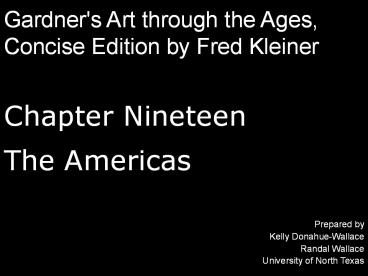Chapter Nineteen - PowerPoint PPT Presentation
1 / 22
Title:
Chapter Nineteen
Description:
Gardner's Art through the Ages, Concise Edition by Fred Kleiner Chapter Nineteen The Americas Prepared by Kelly Donahue-Wallace Randal Wallace University of North Texas – PowerPoint PPT presentation
Number of Views:121
Avg rating:3.0/5.0
Title: Chapter Nineteen
1
Chapter Nineteen
Gardner's Art through the Ages, Concise Edition
by Fred Kleiner
- The Americas
Prepared by Kelly Donahue-Wallace Randal
Wallace University of North Texas
2
Mesoamerica
- Dates and Places
- 1500BCE to 1521CE
- Mexico and Central America
- People
- Polytheistic
- Complex states
- Agriculture
Temple of Quetzalcoatl, Teotihuacan, third
century CE. Fig. 19-3.
3
Mesoamerica
- Themes
- Gods
- Rulers
- Offerings
- Forms
- Conceptual
- Appearance varies by culture
Chacmool, Maya, Chichén Itzá, ca. 800900 CE.
Fig. 19-10.
4
Mesoamerica
- Example
- Olmec
- Colossal heads of rulers
- Basalt stone
- Powerful images
- Face out from plaza
Colossal head, Olmec, 900400 BCE. Fig. 19-2.
5
Mesoamerica
- Example
- Teotihuacan culture
- Place of the gods
- Densely populated city
- Avenue of the Dead
- Temple of the Sun, Pyramid of the Moon, Temple of
Quetzalcoatl, Citadel
Teotihuacan, 50200 CE. Fig. 19-1.
6
Mesoamerica
- Example
- Maya culture
- Ruler portrait in ritual dress
- Stele placed in public plaza
- Sacred precinct
- Name and date in hieroglyphic writing
Stele D, Ruler 13 (Waxaklajuun- Ubaah-Kawiil),
Maya, 736 CE. Fig. 19-4.
7
Mesoamerica
- Example
- Maya culture
- Mesoamerican ball game
- Ritual purpose of game, mythology
- Lifelike, descriptive figure
- Wears ball player garb
Ball player, Maya, 700900 CE. Fig. 19-6.
8
Mesoamerica
- Example
- Aztec culture
- Capital of empire
- Two temples atop pyramid
- Superimposed on earlier pyramids
- In sacred precinct
Great Temple, Aztec, Tenochtitlán, Mexico, ca.
14001500. Fig. 19-12.
9
Mesoamerica
- Example
- Aztec culture
- Colossal relief sculpture at foot of pyramid
- Moon goddess killed by god Huitzilopochtli
- Political message related to sacrifice on pyramid
Coyolxauhqui, Aztec, ca. 1469. Fig. 19-13.
10
South America
- Dates and Places
- 400BCE to 1532CE
- Peru, Colombia
- People
- Polytheistic
- Complex societies
- Agricultural
Embroidered funerary mantle, Paracas, first
century CE. Fig. 19-15.
11
South America
- Themes
- Gods
- Portraits
- Offerings
- Forms
- Conceptual and optical approaches
- Varies by culture
Machu Picchu, Inka, Peru, 15th century. Fig.
19-18.
12
South America
- Example
- Paracas culture
- Mantle to wrap the dead
- Cotton embroidered with alpaca, vicuña
- Real and mythical animal motifs
- Human figures
Embroidered funerary mantle, Paracas, first
century CE. Fig. 19-15.
13
South America
- Example
- Nasca culture
- Gigantic lines
- Scored onto earth
- Defies human perception from ground
- Animals, geometry
- Pilgrimage routes?
Hummingbird, Nasca Plain, ca.500 CE. Fig. 19-16.
14
South America
- Example
- Moche culture
- Painted portrait vessels
- Illustrate Moche life
- Stirrup spout
- Created with molds
- Portrait?
Vessel in the shape of a portrait head, Moche,
fifth to sixth century CE. Fig. 19-17.
15
South America
- Example
- Inka culture
- Mountaintop city
- Known for masonry with dressed stones, no mortar
- Organized around plaza
- Windows and doors frame vistas
Machu Picchu, Inka, Peru, 15th century. Fig.
19-18.
16
North America
- Dates and Places
- First century CE to present
- USA, Canada
- People
- Polytheistic
- Complex societies
- Sedentary and nomadic
- Agriculture and hunting
MARÍA MONTOYA MARTÍNEZ, jar, ca. 1939. Fig. 19-23.
17
North America
- Themes
- Gods
- Offerings
- Utilitarian objects
- Nature/environment
- Forms
- Conceptual
- Forms vary by culture
Kiva mural, Ancestral Puebloan, late 15th to
early 16th century. Fig. 19-21.
18
North America
- Example
- Mississippian culture
- Effigy mound
- Snake associated with crops and fertility
- Path of the comet?
Serpent Mound, ca. 1070. Fig. 19-19.
19
North America
- Example
- Ancestral Puebloan culture
- US Southwest
- Cliff dwellings above valley
- Adobe construction
- Protection from elements
Cliff Palace, Ancestral Puebloan, ca. 11501300.
Fig. 19-20.
20
North America
- Example
- Ancestral Puebloan Culture
- Kiva is spiritual in pueblo complex
- Images associated with agricultural fertility
- Lightning man, fish, eagles, seed, rainbow
Kiva mural, Ancestral Puebloan, late 15th to
early 16th century. Fig. 19-21.
21
North America
- Example
- Hopi culture
- Katsina is supernatural spirit
- Personifies natural elements
- Dolls given to girls
- Rain-bringing deity, geometric design water
OTTO PENTEWA, katsina figurine, Hopi, carved
before 1959. Fig. 19-22.
22
North America
- Example
- Kwakiutl culture
- Northwest coast
- Masks for rituals
- Mask with moving parts for ritual
- Transformative power
Eagle transformation mask, Kwakiutl, late 19th
century. Fig. 19-24.































